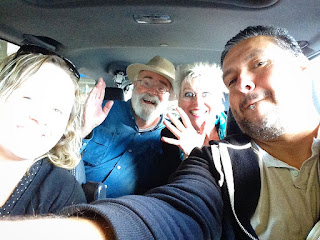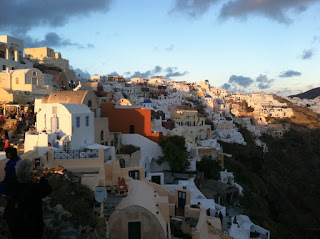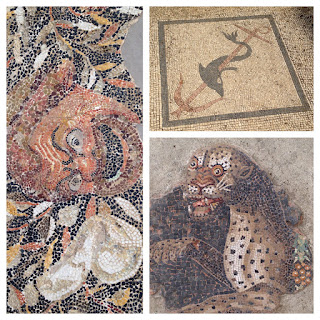We started out on Tuesday morning taking the Rick Steve's Athens City Walk tour. As I've mentioned before, this is a free synchronized audio walking tour that you can listen to on your iPhone. We started off in the center of modern Athens, Syntagma (Constitution) Square, in front of the Parliament. This is one of the many "free range" dogs that you'll find around Athens (along with all of the cats, of course.)
The city tour is supposed to be a two hour tour, but that's if you don't stop anywhere. We stopped in a bookstore and did some shopping. Then we went on to the Cathedral, which is more of a working church than a museum-type sight. In front of the Cathedral is the statue of Archbishop Damaskinos, the church leader who stood up to the Nazis during the occupation of Greece. When a Nazi commander threatened to put Damaskinos before a firing squad for speaking out on behalf of the Jews being deported, the archbishop replied that he should be hanged instead, in good Orthodox tradition.
After the war, he served as the Prime Minister of Greece until the king returned from exile. This statue was erected by Athens Jewish community in thanks.
Another "D" ticket sight we visited was the Temple of Olympian Zeus. These are the remains of the largest temple in mainland Greece. It was begun around 550 BC by the ruler Peisistratos, and finally completed, 700 years later, in 131 AD by the Roman Emperor Hadrian. Although there is not much left, the scale of the columns is awe-inspiring.
All over Athens you can see "free" excavations like the Roman Baths shown here. They are usually uncovered when creating a new subway station. Instead of being closed off, railings are put up so that the public can enjoy the excavation.
After our siesta, we took the Metro out to the suburbs where we had a great evening as well as a wonderful meal, visiting with friends from Calvary Chapel, as well as new friends ministering in Greece. You'll recognize me and Kathy in the upper left. Across from us are our hosts, Sahar and Arno Kamrani, a Persian/Dutch couple living in Greece and working with the refugees flooding into the country. Sahar told us about trying to feed 700 refugees, who showed up one night at one of the camps, by just calling a souvlaki stand and "ordering out". Five hours later the souvlaki arrived.
Frank and Suzie Gonzales, on the left, are working with Sahar in the refugee camps around town, trying to organize medical care for the refugees. Rounding our the dinner party were Mark and Celeste Yocom, who drove down from Kosovo for a few days. Mark is a Calvary Chapel pastor there, who also ministers to the NATO troops still stationed in Pristina.
It was a wonderful night, and we didn't get back to bed until after midnight. (I know; the Greeks are just getting started then!)
On Wednesday morning, we picked up in the middle of the city tour that got cut short yesterday by our desire for an afternoon map. This is the Lysicrates monument, the only remaining "Oscar" awarded to those who appeared in the Theater of Dionysus. This was awarded to "Lysicrates of Kykyna", the winning choral team in the year 334 BC.
Up from the monument, we climbed (and almost crawled) through the little village of Anafiotika on the east slope of the Acropolis. This entire neighborhood was created by people who moved from the tiny island of Anafi after Greek gained its independence from the Ottomans.
On the other side, we came down into the Roman Agora. Because Wednesday was a Greek national holiday, Ohi Day, which commemorates the Greek refusal to bow to Mussolini's ultimatum in WWII, all of the archaeological sights and museums were open to everyone for free, so we didn't need to use our tickets at all. However, everything else, except for restaurants, was closed.
The Roman Forum was definitely a lesser sight; but only because of the multitude of other sights that are all so impressive. Anywhere else, this sarcophagus would be the star on display
Another minor sight was the Library of Hadrian at the side of Monastiraki Square. Once we walked through this, we were at the end of our walking tour, so we celebrated by purchasing a variety of honey-nut pastries along with a cappuccino, and taking a short break.
When we went back to the subway at the Monastiraki Square stop, guess what we found? More ruins. As they were digging the subway stop they found the Roman aqueduct which confined Athens' Eridansos river to a canal. Instead of just digging it up, the modern Athenians excavated the Roman brickwork (you can still see the water running through it), and replaced the floor with glass panels. As you're running to catch your train you can look down into 2000 years of history.
From Monastiraki we headed back to the Acropolis Metro stop to meet Travis and Kristin Spencer, and their three children, for lunch. Travis and Kristin are also working with Calvary Chapel here in Athens and we had a great time catching up.
Well, that's pretty much it. We have our boarding passes printed and we'll leave at 5:00 AM for the airport. It's been a wonderful 44-day adventure, but Kathy says "there's no place like home!"

































































